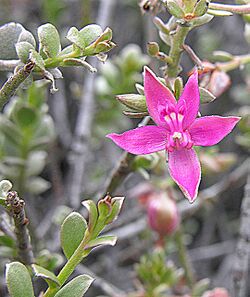Biology:Krameria cistoidea
From HandWiki
Short description: Species of shrub
| Krameria cistoidea | |
|---|---|

| |
| Scientific classification | |
| Kingdom: | Plantae |
| Clade: | Tracheophytes |
| Clade: | Angiosperms |
| Clade: | Eudicots |
| Clade: | Rosids |
| Order: | Zygophyllales |
| Family: | Krameriaceae |
| Genus: | Krameria |
| Species: | K. cistoidea
|
| Binomial name | |
| Krameria cistoidea Hook. & Arn.
| |
Krameria cistoidea is a perennial shrub in the plant family Krameriaceae. The biological action of genus members is caused by the astringent rhataniatannic acid, which is similar to tannic acid.[1] Members of Krameria are found across the Americas, with most native to the tropical regions. An example occurrence is in the Cerro La Campana of central Chile , where it is found in association with the Chilean Wine Palm, Jubaea chilensis.[2] They are perennial shrubs which act as root parasites on other plants. The flowers have glands called elaiophores[3] which produce a lipid which is collected by bees of the genus Centris as they pollinate the flowers.
References
- C. Michael Hogan. 2008. Chilean Wine Palm: Jubaea chilensis, GlobalTwitcher.com, ed. Nicklas Stromberg
- Jepson Manual. 1993. University of California Press, Berkeley, Ca.
- B.B. Simpson. 1982. Krameria (Krameriaceae) flowers: Orientation and elaiophore morphology. Taxon 31:3 517–528
Line notes
- ↑ Chisholm, Hugh, ed (1911). "Rhatany". Encyclopædia Britannica. 7 (11th ed.). Cambridge University Press. p. 231.
- ↑ C. Michael Hogan. 2008
- ↑ B.B. Simpson. 1982
Wikidata ☰ Q4042341 entry
 |

